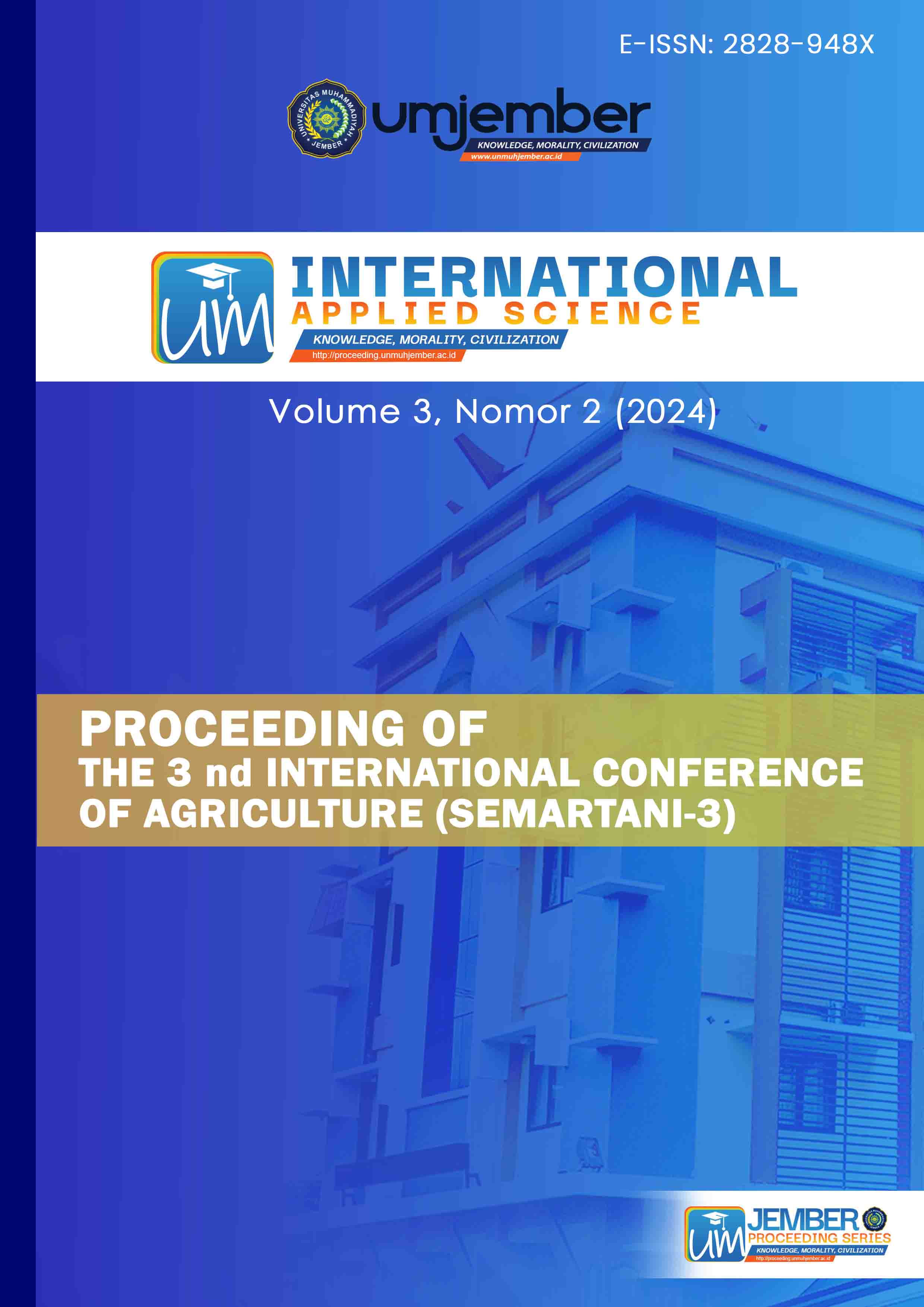Analysis of Added Value and Financial Feasibility of the Oys-ter Mushroom Agroindustry in Jember Regency
DOI:
https://doi.org/10.32528/ias.v3i2.637Keywords:
Oyster mushrooms, Hayami method, financial feasibility analysisAbstract
Jember Regency is one of the oyster mushroom producing districts in Java Province East. The relatively low price of raw oyster mushrooms means that it is not enough to support the economy of oyster mushroom farmers. Efforts to get added value from oyster mushrooms are by processing oyster mushrooms into processed products. The research aims to determine the level of financial feasibility of businesses and the added value of the oyster mushroom agro-industry in Jember Regency. The research was carried out using survey methods and in-depth interviews with oyster mushroom and industry experts as well as secondary data from literature, articles, journals and data from the Central Statistics Agency. Calculating added value using the Hayami method and calculating financial feasibility analysis of products that have high added value. The results of the added value analysis using the Hayami method show that the oyster mushroom product that has the highest added value is oyster mushroom broth amounting to IDR 172,688- (profit percentage 69.08%), oyster mushroom kebab IDR 47,751 (profit percentage 59.69%) and followed by crispy oyster mushrooms amounting to IDR 40,158 (profit percentage 57.37%) followed by oyster mushroom nuggets amounting to IDR 37,048 (profit percentage 55.57%). The financial feasibility results show that the oyster mushroom agro-industry in oyster mushroom broth products is feasible to run. These eligibility criteria show that at an interest rate of 9.75% the NPV value is IDR 626,388,706, the IRR value is 43.25%, the Net B/C Ratio is 1.12 production break-even point is 22,716 units per year, return on capital is 3.86 years. Sensitivity analysis of financial feasibility with an increase in raw material prices of 10%, 20% and 30% still shows a feasible decision. In the sensitivity analysis, a decrease in the product's selling price of 5% and 10% indicates that the decision is feasible, while a decrease in the product's selling price of 15% indicates that the decision is not feasible to carry out.
Downloads
References
S. Sumarsih, Bisnis Bibit Jamur Tiram, Edisi revi. Jakarta : Penebar Swadaya, 2015, 2015.
Badan Pusat Statistik Indonesia, “Produksi Tanaman Sayuran dan Buah-buahan Semusim Menurut Jenis Tanaman (ton), 2019–2022,” Statistik Indonesia 2023.
Badan Pusat Statistik, “Luas Panen Tanaman Sayuran Jamur Tiram Di Jawa Timur.”
Badan Pusat Statistik Jawa Timur, “Produksi jamur Tiram di Provinsi Jawa Timur (kuintal), 2021 dan 2022.”
V. Agustini, S. Sufaati, B. Elita Bharanti, and D. Y. Runtuboi, “Cultivation of Oyster Mushroom As a Model and Profitable Unit at Cenderawasih University,” J. Pengabdi. Masy. MIPA dan Pendidik. MIPA, vol. 2, no. 1, pp. 28–32, 2018, [Online]. Available: http://journal.uny.ac.id/index.php/jpmmp
L. Nailufaroh, D. N. Pitasari, and N. S. Suprihatin, “Peningkatan Produktivitas Budi Daya Jamur dan Pengeloaan Keuangan Pada Kelompok Tani Jamur Lestari Desa Batok Bali - Provinsi Ban-ten,” Semin. Nas. Pengabdi. Kpd. Masyarakat, Semin. dalam Jar. LPPM Univ. Negeri Medan, pp. 221-, 2022.
E. Triono, “Budidaya Jamur Tiram dan Pengolahannya Sebagai Upaya Meningkatkan Ekonomi Kreatif Desa Kaulon,” J. Karinov, vol. 3, no. 2, pp. 2–6, 2020.
C. Kusuma, M. Hisjam, and W. Sutopo, “Value ChainAnalysis of Cantula Fiber as a Material of Electric Vehicle Interior,Proceedings-JointInternational Conference on Electric VehicularTech-nology and Industrial, Mechanical, Electricaland Chemical Engineering,” ICEVT 2015 IMECE2015, 2016, doi: https://doi.org/10.1109/ICEVTIMECE.2015.7496699.
T. R. Robinson, H. van Greuning, E. Henry, and M. A. Broihahn, International Financial State-ment. 2020.
M. Giatman, Ekonomi Teknik, 5th ed., no. July. Jakarta, 2017.
H. Septianingtyas and M. Hayati, “Manajemen produksi dan kelayakan finansial tambak udang vanamei CV Indah Grup di Kabupaten Sumenep,” Agriscience, vol. 3, no. 2, pp. 385–597, 2022, doi: 10.21107/agriscience.v3i2.15542.
S. Ceufin, “Kelayakan Usaha Pada Agribisnis Ayam Petelur Studi Kasus Pada Cv. Gali Putra Junrejo Malang,” Berk. Ilm. AGRIDEVINA, vol. 9, no. 1, pp. 39–52, 2020, doi: 10.33005/adv.v9i1.2207.
D. R. Anderson, D. J. Sweeney, T. A. Williams, J. D. Camm, and J. J. Cochran, An Introduction to Management Science: Quantitative Approaches to Decision Making, 15th ed. Boston: Cengage Learning, 2019.
P. P. R. Tenawaheng, C. Utomo, and I. P. A. Wiguna, “Analisis Sensitivitas Investasi Apartemen Begawan,” J. Tek. ITS, vol. 10, no. 1, pp. 25–30, 2021, doi: 10.12962/j23373539.v10i1.61284.
M. Abdul-Hamid, R. Galaly, R. R. Ahmed, and H. M. Hamdalla, “Monosodium Glutamate as a Food Additive: Toxic Implications and the Protective Role of Quercetin,” Merit Res. J. Med. Med. Sci., vol. 5, no. 8, pp. 384–402, 2017, [Online]. Available: http://www.meritresearchjournals.org/mms/index.htm
Riset Kesehatan Dasar (Riskesdas), “Badan Penelitian dan Pengembangan Kesehatan Kemen-terian RI tahun 2018,” Kementrian RI, Jakarta.
N. Widyastuti, D. Tjokrokusumo, and R. Giarni, “Potensi beberapa jamur basidiomycota sebagai bumbu penyedap alternatif masa depan,” Pros. Semin. Agroindustri dan Lokakarya Nas. FKPT-TPI, pp. 52–60, 2015.
N. Feranika and E. N. Dewi, “Analisis Ekonomi Pra Rancangan Pabrik Kimia Pembuatan Bubuk Kaldu Jamur Tiram Kapasitas 5000 Ton/Tahun,” DISTILAT J. Teknol. Separasi, vol. 9, no. 1, pp. 50–58, 2023, doi: 10.33795/distilat.v9i1.524.
P. W. Arnold, P. Nainggolan, and D. Damanik, “Analisis Kelayakan Usaha dan Strategi Pengem-bangan Industri Kecil Tempe di Kelurahan Setia Negara Kecamatan Siantar Sitalasari,” J. Ekuilnomi, vol. 2, no. 1, pp. 29–39, 2020, doi: 10.36985/ekuilnomi.v2i1.349.
R. Adiguna, S. Luhut, and Salmiah, “Analisis Kelayakan Investasi Pembangunan Pabrik Minyak Kelapa Sawit (PMKS) (Studi kasus Kabupaten Nagan Raya, Provinsi NAD),” J. Agribisnis, pp. 1–15, 2014.
Downloads
Published
How to Cite
Issue
Section
License

This work is licensed under a Creative Commons Attribution-NonCommercial 4.0 International License.


